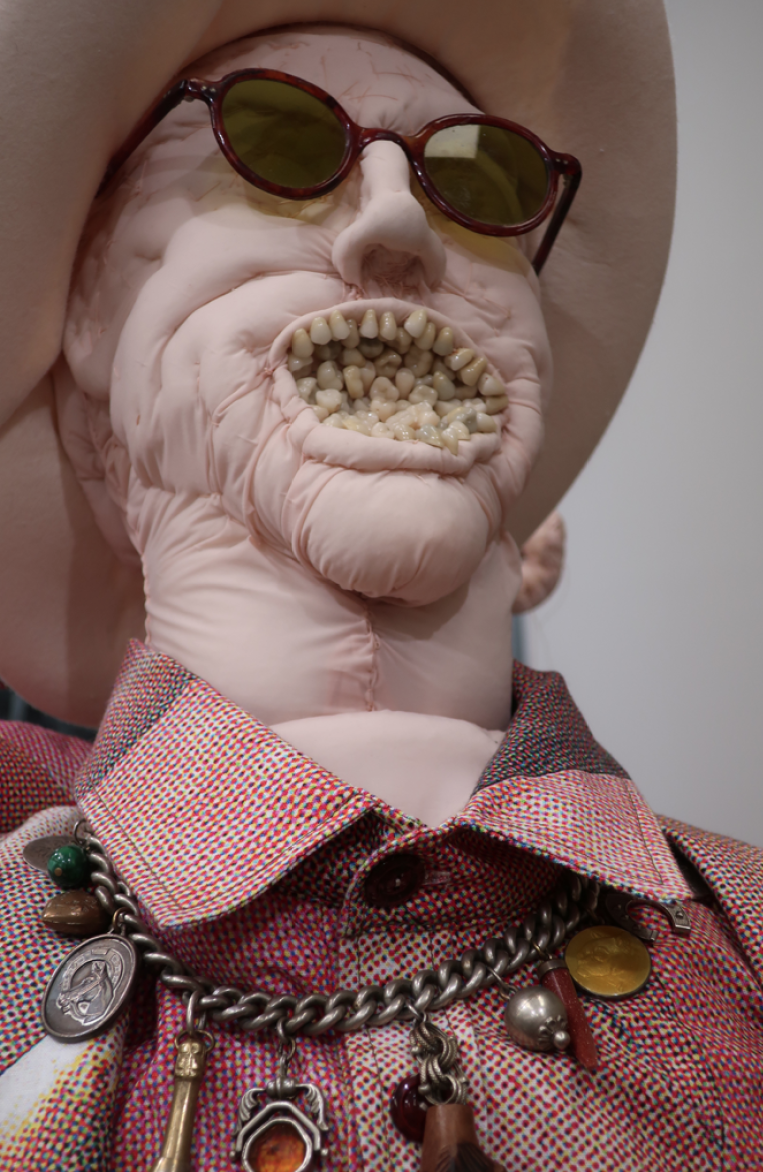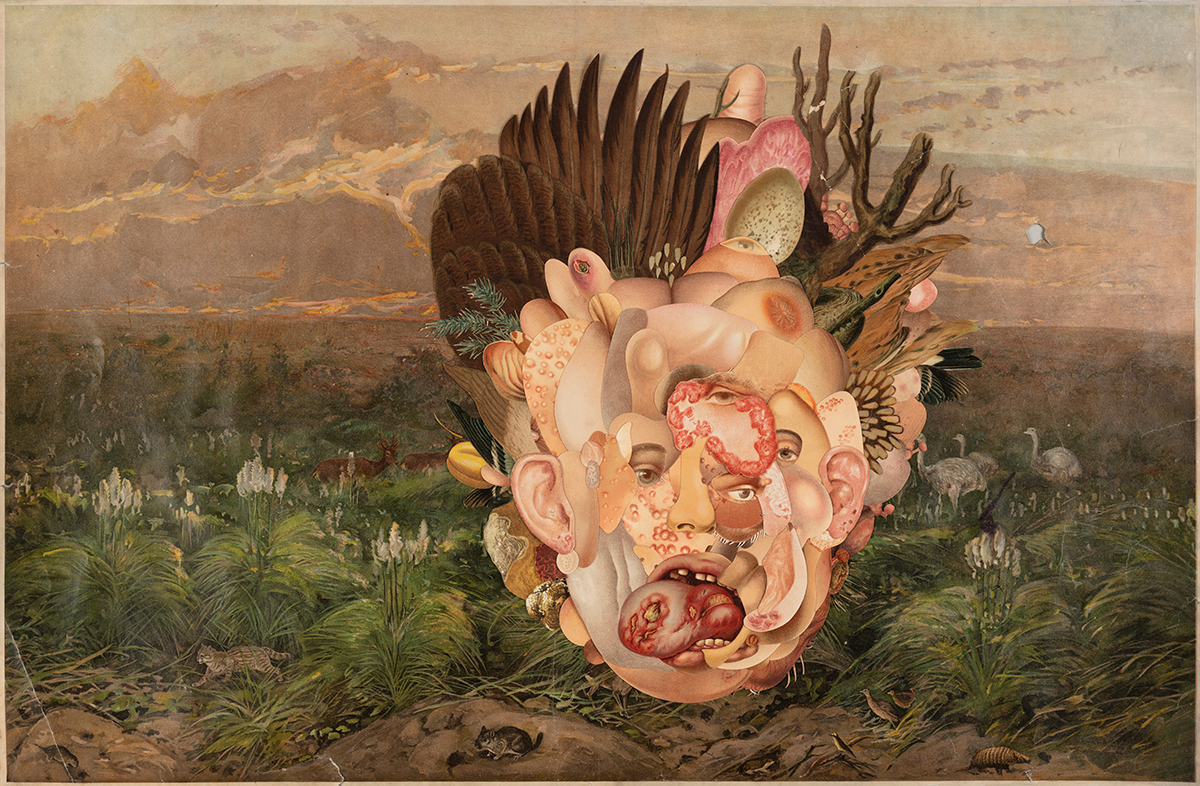The Austrian artist places the current COVID-19 crisis in a historical context in which such states of emergency are the rule rather than the exception

all images Courtesy the artist
Following the completion of a carpenter’s apprenticeship and a relatively late start in art, Austrian Ines Doujak first came to wider attention for Siegesgärten (Victory Garden), a 2007 work shown that year at Documenta 12 in Kassel. A raised flowerbed installation, it featured conventionally designed seed packets on which, in the place of instructions for the germination and care of seedlings, were printed texts addressing the far-reaching consequences of land grabbing, bio-piracy and monopoly in the seed industry: an efficient presentation of an urgent situation to a large and diverse audience. This kind of thematic scrolling through and clarification of complex global economic processes and practices that have large, not always measurable, but often catastrophic consequences for the individual is a feature one encounters in the artist’s work again and again. The fact that her long-term, research-based artistic works and projects so often turn out to be topical may have less to do with an obvious striving for relevance than with the fact that many of the problems and imbalances of the present stem from economic and historical injustices that are the focus of the artist’s meticulous attention. This focus has been evident since she first started showing her work, in the noughties, across topics ranging from concepts of homeland (for example through the history of Carinthian Slovenes, an indigenous minority living within Austria’s borders), anti-Semitic image politics, heteronormativity and representations of age and femininity.


Doujak’s papier–mâché sculpture for Not Dressed for Conquering (Transport) (2010), shown in the group-exhibition The Beast and the Sovereign (2015) at MACBA in Barcelona and depicting King Juan Carlos I of Spain, the Bolivian labour leader and activist Domitila Chúngara and a German shepherd engaged in a sexual act, attracted such attention regarding its inclusion in the show that it forced the resignation of MACBA director Bartomeu Marí and the dismissal of cocurators Valentín Roma and Paul B. Preciado. In the process, the very questions posed by the exhibition – ‘Is sovereignty possible beyond power? Can sovereignty occur by questioning relations of dominance?’ – were put to a real public test.

Her research project Loomshuttles, Warpaths (2010–18), developed with longtime collaborator John Barker, examined the troubled relationship of fabrics, clothing and the conditions of their manufacture, starting with early forms of global capitalism. This led to the creation of an haute couture collection that, among other things, visualised cost calculations made at the expense of textile-worker safety through the garment itself. The artist went on to show these works in, among other places, the setting of an eight-part popup display, where the collection could be admired, touched and even tried on in specially built changing rooms (SALE, 2018, Lentos Kunstmuseum, Linz).

Invited to take part in the Liverpool Biennial, originally scheduled for 2020, the artist proposed a large sculpture for the opening parade, which, when cancelled (for well-known reasons; the biennial itself was postponed to this year), was reconceived, again with Barker, as Transmission: A series of five podcasts on Disease and Pandemics in a Distorted World (2021). Divided into approximately 30-minute programmes structured around the terms Vaccine, Meat, Forked Tongue, Class and Blame, the podcasts trace the origins and effects of pandemics throughout history. In these informative and entertaining sound collages, musical genres (medieval, folk, lounge, electronic…), audio samples, historical data and facts on the history and spread of pandemics are presented by different speakers and musicians reading from texts by the artists. What becomes apparent, in these long-term portraits of Homo sapiens and viruses, are the recurring patterns in the causes and effects of pandemics.

Vaccine details the history of poor people, slaves, prisoners and soldiers who have been intentionally, but without their knowledge, infected over centuries for the purposes of medical study in the fight against various pandemics: syphilis, malaria, HIV. As shown in the case of two French doctors who lobbied last year to use Africa as a testing ground for COVID-19 vaccinations, it is often a fundamentally racist way of thinking, and one that sadly persists. For its accounts of how the privatisation of healthcare systems in the West made it easier for the virus to spread, of the speed with which the virus circulated and of inaccuracies in media coverage of the race to develop the Biontech, Moderna, Astra Zeneca and Sputnik vaccines, the horror and drama of the first part of the series is hard to beat. Meat investigates how industrial meat production has helped create ideal conditions for the spread of disease: as forests are cleared to create space to grow feed for cattle, environmental pressure is transferred to animals, which in turn transfer viruses to humans.


In Forked Tongue, Doujak and Barker describe the pandemic from their point of view, sometimes in a laconic way. You find out here, for example, that the pair’s polystyrene sculpture, elaborately produced for the parade, caused a serious studio fire. You hear of their daily battles with lockdown fatigue, and the political powerlessness engendered by state-mandated passivity. Class opens on the role played by the Austrian ski resort Ischgl in the spread of the virus across Europe, and recalls a timely pandemic-preparedness exercise organised in New York in October 2019. Also discussed: the spike in US gun sales between March and July 2020; the sudden popularity in England of previously unloved castles; studies of historic pandemics in Ecuador, Italy and Mexico that consistently show higher death rates in poorer sections of the population; the way astonishment that a wealthy district of Paris could suffer such high mortality during the Spanish flu epidemic in 1918 quickly faded as it became apparent the dead were servants of the residents. The fifth and final part, Blame, also makes reference to past pandemic outbreaks, such as to the New York cook Mary Mallon, an asymptomatic carrier of disease who, after infecting 53 others, was forcibly quarantined for the final two decades of her life and has forever after been known as Typhoid Mary. It shows how culprits for pandemics have always been sought, and how they are almost always ‘found’ among the usual suspects (the poor, the dirty, migrants, strangers…). In addition to providing a summary of events, a global context and an analysis of the rhetoric used by the various actors and interest groups during COVID-19, Transmission places the current pandemic in a historical context in which such crises and states of emergency are the rule rather than the exception.


Doujak’s work has always aimed at uncovering knowledge and presenting complex forces in a manner that brings them back to a level on which they can be consciously perceived. Further opportunities to experience the results of her long-running, research-based projects can be found in this year’s Vienna Biennale, where her exhibition Landscape Painting, at the Kunsthaus Wien, is dedicated to investigating and exposing the practice of land grabbing; and in a large retrospective of her work of the past three decades, to be shown at the Kunsthalle Wien in the autumn.
Ines Doujak: Landscape Painting is on view at the Kunsthaus Wien through 3 October; a retrospective of her work will be on show at Kunsthalle Wien, 1 October – 16 January; and her project, with John Barker, for Liverpool Biennial 2021, Transmission: A series of five podcasts on Disease and Pandemics in a Distorted World, is currently available through the biennial website
Christian Egger is an artist and author based in Vienna. His book Shows, Signals, Unvernehmen: Collected Re- & Interviews 2005–2020 was published last year
From the Summer 2021 issue of ArtReview